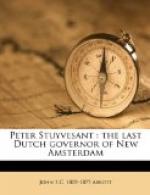“This,” said they,
“is contrary to the granted privilege of the Netherland government and odious to every free-born man; and especially so to those whom God has placed in a free state in newly-settled lands, who are entitled to claim laws not transcending, but resembling as near as possible those of the Netherlands.”
There were several minor offences enumerated to which we need not here refer. The memorial was drawn up by an Englishman, George Baxter. The imperious Stuyvesant was greatly annoyed by this document. To weaken its effect, he declared that the delegates had no authority to act or even to meet upon such questions. He endeavored to rouse national prejudice against the document by saying:
“The most ancient colony of Manhattan, the colonies of Rensselaerswyck and Staten Island and the settlements at Beaverswyck and on the South river are too prudent to subscribe to all that has been projected by an Englishman; as if among the Netherlands’ nation there is no one sagacious and expert enough to draw up a remonstrance to the Director and council.”
CHAPTER VIII.
ANOTHER INDIAN WAR.
Conflict Between the Governor and the Citizens.—Energy of the Governor.—His Measures of Defence.—Action of the English Colonies.—Claims of the Government of Sweden.—Fort Casimir captured by the Swedes.—Retaliation.—Measures for the recapture of Fort Casimir.—Shooting a Squaw.—Its Consequences.—The Ransom of Prisoners.—Complaints of the Swedish Governor.—Expedition from Sweden.—Its Fate.
There was a brief but bitter controversy between the governor and the convention, when the governor ordered the body to disperse, “on pain of our highest displeasure.” “We derive our authority,” said he, “from God, and from the Company, not from a few ignorant subjects. And we alone can call the inhabitants together.” These decisive measures did not stifle the popular voice. Petitions were sent to the Company in Holland, full of complaints against the administration of Stuyvesant, and imploring its intervention to secure the redress of the grievances which were enumerated.
An able man, Francois le Bleuw, was sent to Holland with these documents, with instructions to do everything in his power to procure the reforms they urged. Though the citizens of New Amsterdam had, for a year, enjoyed a limited municipal government, they were by no means satisfied with what they had thus far attained. What they claimed, and reasonably claimed, were the larger franchises enjoyed by the cities in the fatherland.
The condition of New Netherland, at the commencement of the year 1654, was very precarious. The troubled times, as is ever the case, had called out swarms of pirates and robbers, who infested the shores of Long Island, inflicting the most cruel excesses upon the unprotected inhabitants. The English residents in the Dutch colonies were numerous, and they were ripe for revolt. The Dutch themselves were uttering loud murmurs. The governor acted with his accustomed energy. Several vessels were fitted out to act against the pirates. Many of these pirates professed to be privateersmen, serving the Commonwealth of England. It was suspected that the English residents were communicating with the freebooters, who were chiefly their own countrymen.




